Related Research Articles
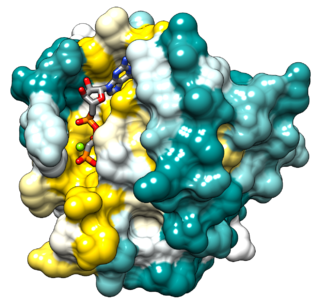
Ras, from "Rat sarcoma virus", is a family of related proteins that are expressed in all animal cell lineages and organs. All Ras protein family members belong to a class of protein called small GTPase, and are involved in transmitting signals within cells. Ras is the prototypical member of the Ras superfamily of proteins, which are all related in three-dimensional structure and regulate diverse cell behaviours.
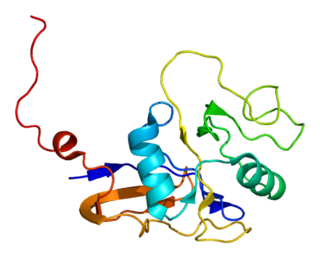
GTPase HRas, from "Harvey Rat sarcoma virus", also known as transforming protein p21 is an enzyme that in humans is encoded by the HRAS gene. The HRAS gene is located on the short (p) arm of chromosome 11 at position 15.5, from base pair 522,241 to base pair 525,549. HRas is a small G protein in the Ras subfamily of the Ras superfamily of small GTPases. Once bound to Guanosine triphosphate, H-Ras will activate a Raf kinase like c-Raf, the next step in the MAPK/ERK pathway.

Ran also known as GTP-binding nuclear protein Ran is a protein that in humans is encoded by the RAN gene. Ran is a small 25 kDa protein that is involved in transport into and out of the cell nucleus during interphase and also involved in mitosis. It is a member of the Ras superfamily.

Ras homolog gene family, member B, also known as RHOB, is a protein which in humans is encoded by the RHOB gene.

NRAS is an enzyme that in humans is encoded by the NRAS gene. It was discovered by a small team of researchers led by Robin Weiss at the Institute of Cancer Research in London. It was the third RAS gene to be discovered, and was named NRAS, for its initial identification in human neuroblastoma cells.

Ras-related protein Rap-1A is a protein that in humans is encoded by the RAP1A gene.
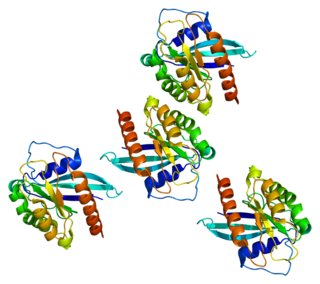
Ras-related protein Rab-7a is a protein that in humans is encoded by the RAB7A gene.
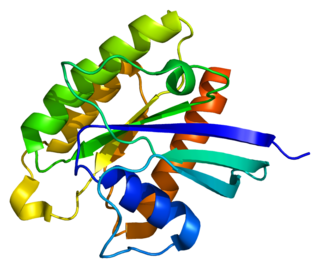
RHEB also known as Ras homolog enriched in brain (RHEB) is a GTP-binding protein that is ubiquitously expressed in humans and other mammals. The protein is largely involved in the mTOR pathway and the regulation of the cell cycle.

Ras-related protein Ral-A (RalA) is a protein that in humans is encoded by the RALA gene on chromosome 7. This protein is one of two paralogs of the Ral protein, the other being RalB, and part of the Ras GTPase family. RalA functions as a molecular switch to activate a number of biological processes, majorly cell division and transport, via signaling pathways. Its biological role thus implicates it in many cancers.

Ral guanine nucleotide dissociation stimulator is a protein that is encoded by the RALGDS gene in humans.
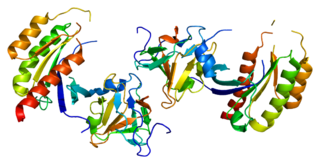
Ras-related protein Rab-8A is a protein that in humans is encoded by the RAB8A gene.

Ras-related protein Rap-2b is a protein that in humans is encoded by the RAP2B gene. RAP2B belongs to the Ras-related protein family.
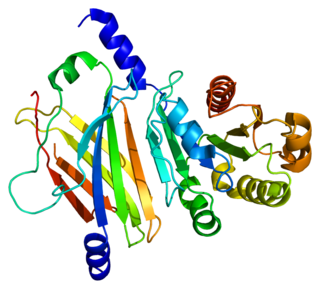
Retinal rod rhodopsin-sensitive cGMP 3',5'-cyclic phosphodiesterase subunit delta is an enzyme that in humans is encoded by the PDE6D gene. PDE6D was originally identified as a fourth subunit of rod cell-specific cGMP phosphodiesterase (PDE). The precise function of PDE delta subunit in the rod specific GMP-PDE complex is unclear. In addition, PDE delta subunit is not confined to photoreceptor cells but is widely distributed in different tissues. PDE delta subunit is thought to be a specific soluble transport factor for certain prenylated proteins and Arl2-GTP a regulator of PDE-mediated transport.
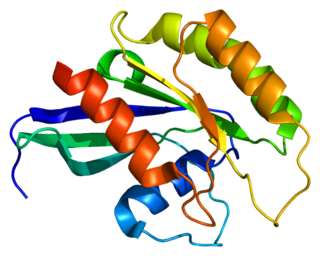
Ras-related protein Rab-26 is a protein that in humans is encoded by the RAB26 gene.

Eukaryotic translation initiation factor 1A, Y-chromosomal is a protein that in humans is encoded by the EIF1AY gene.

Ras-related GTP-binding protein B is a protein that in humans is encoded by the RRAGB gene.
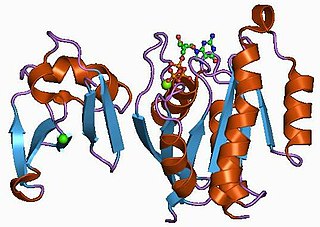
Ras-related protein Rap-1b, also known as GTP-binding protein smg p21B, is a protein that in humans is encoded by the RAP1B gene.

GTP-binding protein Di-Ras3 (DIRAS3) also known as aplysia ras homology member I (ARHI) is a protein that in humans is encoded by the DIRAS3 gene.

Ras and EF-hand domain-containing protein also known as Ras-related protein Rab-45 is a protein that in humans is encoded by the RASEF gene.

Ras-related protein Rab-2B is a protein that in humans is encoded by the RAB2B gene.
References
- ↑ "RAP1A RAP1A, member of RAS oncogene family". Entrez Gene. United States National Library of Medicine.
- ↑ Rousseau-Merck MF, Pizon V, Tavitian A, Berger R (1990). "Chromosome mapping of the human RAS-related RAP1A, RAP1B, and RAP2 genes to chromosomes 1p12----p13, 12q14, and 13q34, respectively". Cytogenet. Cell Genet. 53 (1): 2–4. doi:10.1159/000132883. PMID 2108841.